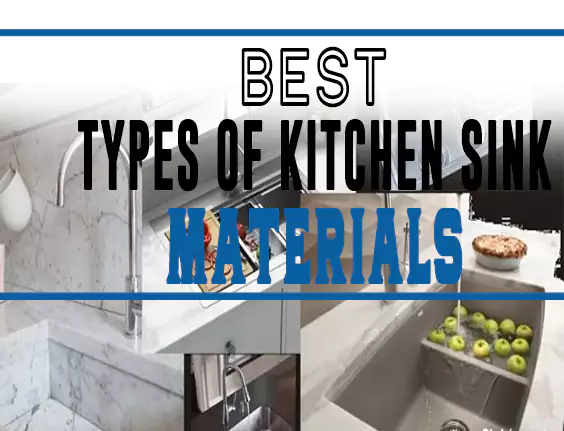Knowing about the best kitchen sink materials will surely help when upgrading or renovating a dream kitchen. We compare the top 10 options.
Kitchen sinks are offered in different styles, designs, and materials. With the vast variety of kitchen sink materials, choosing the right material should be a top priority.
You need to consider countertop material, style and color, place, kitchen decoration, and some other factors when choosing the kitchen sink material.
Recently, I remodeled my kitchen. I went through detailed research and experience. I’m sharing my experience, hopefully, it would be helpful!
Most Durable Kitchen Sink Materials
| Material | Best for | Lifespan (Years) | Cleaning | Durability | Price |
|---|---|---|---|---|---|
| Stainless Steel | All Types of Kitchen Sink | 20-30 | Easy | 5/5 | Get Idea |
| Copper | Farmhouse Kitchen Sink | 40-50 | Easy | 5/5 | Get Idea |
| Fireclay | Farmhouse Kitchen Sink | 20-30 | Easy | 5/5 | Get Idea |
| Cast Iron | White Kitchen Sink | 30-40 | Easy | 5/5 | Get Idea |
| Granite Composite | Black Kitchen Sink | 40-50 | Easy | 5/5 | Get Idea |
| Quartz Composite | Undermount Kitchen Sink | 40-50 | Easy | 5/5 | Get Idea |
| Solid Surface | Undermount Kitchen Sink | 20-30 | Easy | 4.5/5 | Get Idea |
| Acrylic | Black Kitchen Sink | 15-25 | Easy | 4.5/5 | Get Idea |
| Pure Stone | Transitional Kitchen Sink | 90-100 | Easy | 4.5/5 | Get Idea |
| Porcelain | White Kitchen Sink | 20-30 | Easy | 4.5/5 | Get Idea |
Best Kitchen Sink Materials
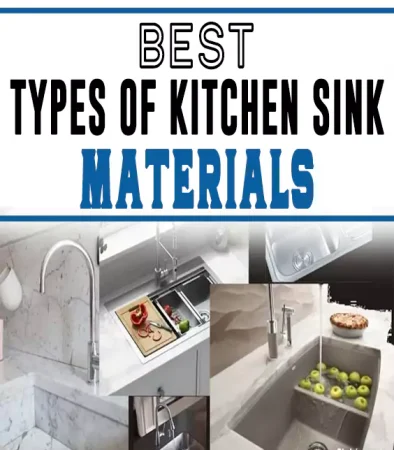
1. Stainless Steel
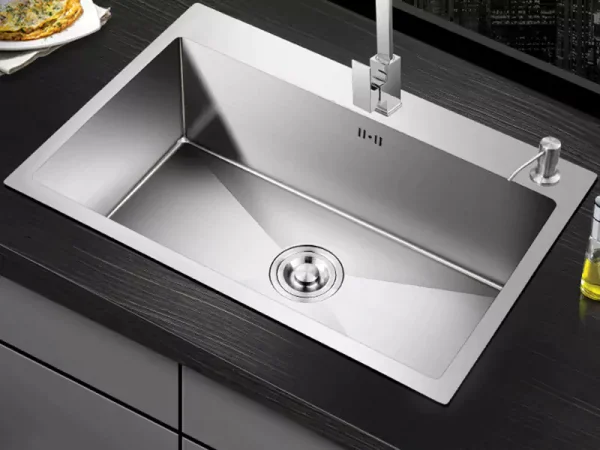
The stainless steel sink is one of the most affordable kitchen sinks on the market today. Stainless steel sinks are chip-free; they also do not rust and do not corrode easily.
It is designed for heavy-duty use. Even restaurants use them for massive dishwashing activities.
They can withstand high temperatures. Stainless steel sinks won’t break nor chip even if you toss them in a sizzling pan in it. They also do not scratch easily. With proper maintenance after every use, it will surely last you a long time.
Although it is quite noisy, most stainless steel sinks today are padded with noise-controlling rubbers that will help lessen the noise during use.
One thing to remember with stainless steel sinks is their gauge and series number. The lower the gauge, the thicker the metal is.
Opt to buy the ones that are 16 to 18 gauge. Also, look for the series number that is 300 and above. It will be beneficial for you when it comes to rust and corrosion because of its chromium and nickel content.
This kitchen sink material is one of the most common sink materials found in most homes. A survey even shows that 70% of the most widely sold kitchen sinks are made of stainless steel material.
If anybody asks me what’s the best kitchen sink material? I absolutely prefer: Stainless Steel.
Pros of Stainless Steel Material:
- Affordable
- Best for all types of kitchen use
- Easy maintenance
- Can withstand high temperatures
- For heavy-duty use
Cons of Stainless Steel Material:
- Noisy
- Can show water spots
2. Cast-Iron
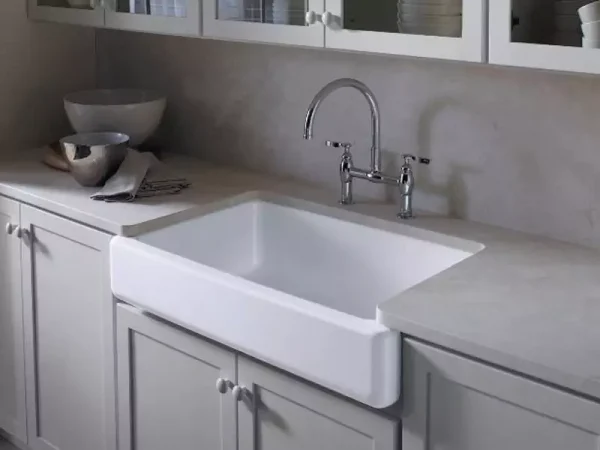
If you want a bright, shiny, and smooth appearance for your sink, then you might be interested in a cast iron kitchen sink.
Originally, irons are very prone to rust and that’s one major drawback to this material. However, that dilemma is never a problem anymore with the help of the heavy porcelain enamel coated finish on cast-iron sinks nowadays.
With the porcelain enamel finish, it prevents stains and rust buildup. This also makes it very easy to maintain.
With just the use of your wet cloth and mild cleanser, you can easily bring back the shine and maintain its beautiful look, free from water spots and discoloration.
One of the best features of a cast iron sink is its durability. Because of its hard quality material, it will surely stand the test of time when accompanied by proper care and maintenance.
This is also offered in various styles and designs. However, you may be required to add a reasonable cost if you want it in another color except white.
Keep in mind that a cast-iron sink is three times heavier than a stainless steel sink. Thus, this will require a professional upon installation. They will put up a support framework under your sink to ensure that it won’t fall off upon use.
Abrasive cleaners are also discouraged in this type of sink. Merely because the enamel coating might chip and expose the iron material underneath and furthermore lead to rust buildup.
Pros of Cast Iron Material:
- Easy maintenance
- Offered in a wide variety of styles
- Water spots proof
- Enamel coating prevents rust and stains
- Durable
Cons of Cast Iron Material:
- Very heavy
- Pricey especially with other colors except white
3. Copper
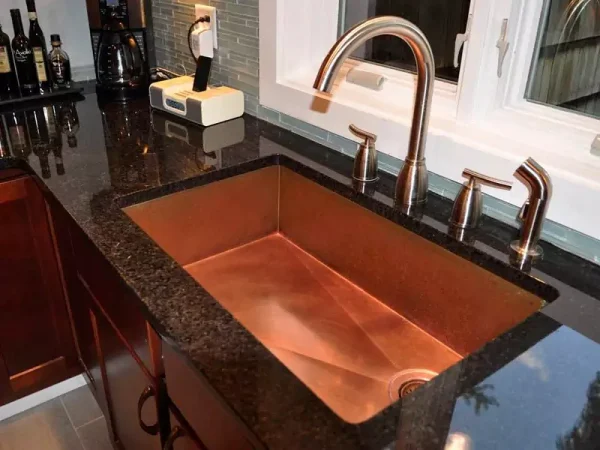
When we talk about copper, what comes to mind first is vogue, vintage, and value. Copper kitchen sinks are one of the few sinks that never go out of style. It is indeed a timeless beauty!
Although various materials came out, only a few remain as timeless trends and vogue throughout the years.
When you want an antique and classy look, having a copper farmhouse sink will surely be the best option for you.
Its bronze color makes it stand out and the patina elevates the posh and class of your kitchen area. As the years pass by, the value of a copper sink is also appreciated.
Apart from those three great features that copper sinks offer, copper is also one of the best kitchen sink materials when it comes to functionality.
Coppers as we know have this antimicrobial property which makes it very ideal for kitchen use. If hygiene is one of your top concerns, then this is surely your best choice.
It is also high-thermal resistant which allows it to withstand high temperatures. So, when you need to toss in a smoky hot pot, no need to worry about cracks and breakage.
Rust, indentations, and corrosion are also very minimal in this type of sink as long as you give it proper cleanup and maintenance.
Because of its wide array of features, it is known to be very pricey but its high price will surely last you a lifetime.
Pros of Copper Material:
- Very durable
- Appreciating value
- High thermal assistance
- Rust-free
- Has antimicrobial property
Cons of Copper Material:
- Offered in one color only
- Very expensive
4. Fireclay
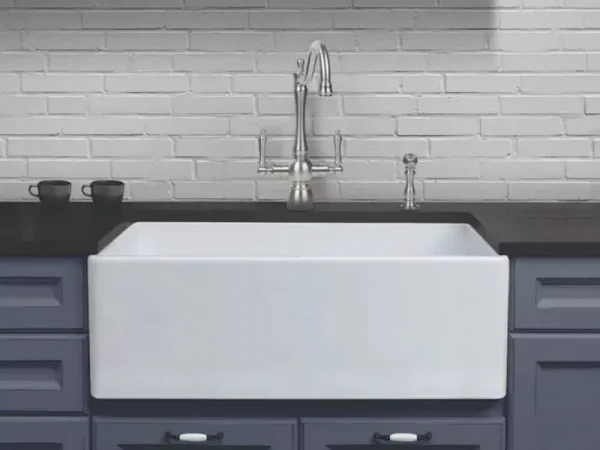
This type of material is molded white clay that is fused with glaze and heated to a very high temperature. Because of this way of production, the finished product comes out to be very strong, durable, and highly thermal resistant.
Because of its glossy enamel finish, it is stain and scratch-free. If unfortunately cracks, you can repair cracks easily in the fireclay sink.
With just using a wet cloth and a mild cleaner, you’re surely able to clean it and bring back its shine. You can also reglaze it when you want it back to its original shine and gloss.
Fireclay farmhouse kitchen sinks offer a wide array of styles and designs. Although it has limited color options such as white, off-white, black, and blue, it is still very appealing to buyers and new homeowners.
Because of its heavy weight, our DIY guys will really need the help of a professional to secure its stability. Professional installers will secure a support framework to help carry the weight of the sink.
You also need to be careful when handling this type of material because it will surely break when accidentally dropped on the ground. It can also crack when mishandled during installation.
Pros of Fireclay Material:
- High thermal resistance
- Robust build quality
- Stain and scratch free
- Comes in different styles and minimal colors
- Highly durable
Cons of Fireclay Material:
- Heavyweight
- Professional installation required
5. Pure stone
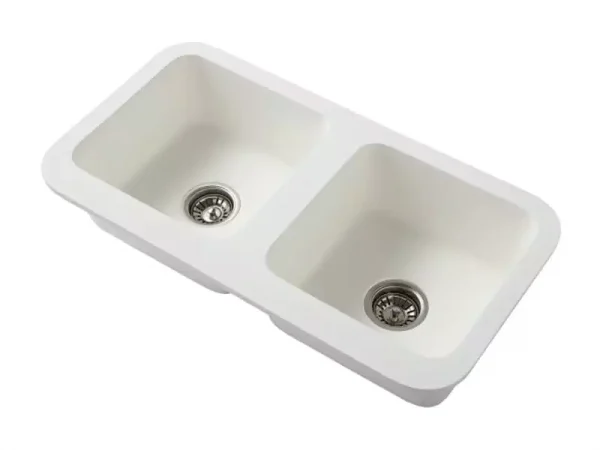
When you want your kitchen sink to be natural looking with a touch of class and posh, stone material has got to be your choice.
Pure stones such as granite and quartz are indeed at the top high end when it comes to market price. That’s why if money is never a concern, let pure stone sinks get your attention.
The natural variegations and pigmentations of every stone sink are unique and different from each other. The subtle variation and texture are preserved. That’s why a lot of people get very attracted to it.
Though granite and quartz are both natural stones, they differ in some ways too.
Granite belongs to the group of igneous rocks that are known to be very strong and heat resistant.
However, because of its porosity, stains and grimes might sink in if you don’t scrub the surface well after every use. This material also requires additional sealing to solve its porous nature.
On the other hand, quartz is a rock-forming mineral. Unlike granite, it is non-porous in nature which makes it impenetrable to dirt and stains.
Amidst their differences, these two are still considered as one of the most durable kitchen sink materials.
However, one downside to this material is its inability to endure high temperatures. So, if you want this material, make sure to run cold water down your sink when you need to put hot items in it.
But when it comes to longevity and durability, these two will never fail you. With proper handling and maintenance, this will surely last you many years.
Also, take into consideration the weight of this material. Due to its very heavy weight, you will be needing a professional’s help for installation. They will put up reinforced cabinetry which obviously adds up to the cost.
Pros of Cast Iron Material:
- Best for all types of kitchen use
- Long life span
- Adds extra posh and chic to your home
- Very durable
- Unique
Cons of Cast Iron Material:
- Very heavy
- Scratches are more visible in darker colors
6. Stone Composite
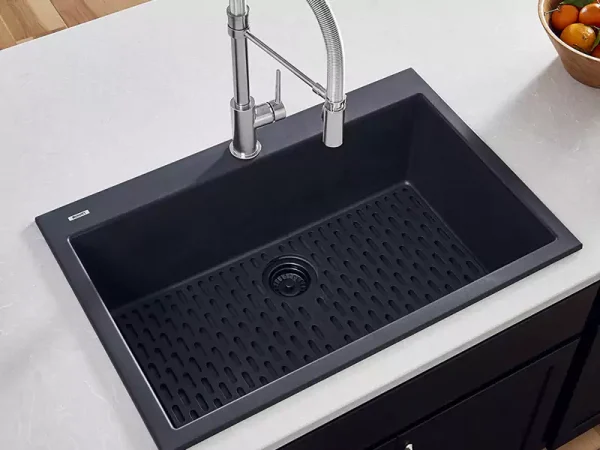
As mentioned earlier, pure stones are indeed beautiful but very pricey. If you want a resemblance to a pure stone kitchen sink but your wallet does not allow you, simply composite it up!
This is indeed your best option. Here’s why.
Technically, stone composite is made up of two elements which are usually granite stone dust and acrylic resins that act as a binder. Some stone composites also offer quartz as the primary stone dust element.
Mixing these two elements under high compression creates a very solid and durable material. This will be strong enough to withstand heavy use but still have that pure granite aesthetic. Thus, making it a durable sink material.
Pure stone is usually variegated because of the innate pattern of the stone. Composite on the other hand is more consistent in its look and can be styled in many more options.
Stone composite is considered one of the best materials for kitchen sinks. They play a good game under heavy use. No need to worry about scratches, stains, and rust because they will never be visible in this material.
Because of its non-porous nature, this requires no sealing.
A downside of this material is that they are offered in a matte finish only. They are also very heavy just like pure stone sinks. You also need to keep in mind that exposing it to extreme heat may cause damage or cracks on its surface.
Pros of Stone Composite Material:
- No sealing required
- Abrasion proof
- Easy maintenance
- Cheaper than pure stone
- Wide range of styles and colors
Cons of Stone Composite Material:
- Only available in matte finish
- Can crack when exposed to extreme heat
7. Glass
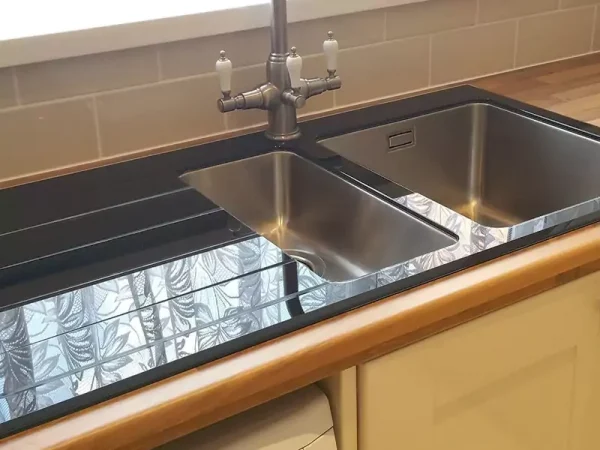
This may be very limited but is still an option. It is not very common but some houses still opt for a glass kitchen sink.
Here’s why.
Glass kitchen sinks are highly stylish and classy. They are offered in a number of different bright colors with high gloss. Because of its sleek and slim style, it will have a low profile on your workspace.
If you worry about its functionality, just like any other kitchen sink, it has its own safety handling requirements too.
Typically, glass materials are very fragile to handle. It can definitely crack or break under high impact like a frying pan falling onto your sink. However, glass items nowadays are already tempered.
This makes the glass material resistant to heat and able to endure a certain impact strength. This also helps the glass kitchen sink withstand the most common household chemicals which some kitchen sinks are very sensitive to.
A few drawbacks to glass kitchen sinks is their limited choice of styles as they are only sold as flush mounting sinks or inset sinks.
They are also more costly compared with stainless steel sinks, which are everybody’s going to sink.
Although it is considered a scratch-resistant sink, it can still scratch when abraded by hard grits.
If you could assess that your kitchen sink will not be as busy as the other household kitchen and you just want your kitchen to have a classy and stylish feel with minimal functionality, then a glass kitchen sink can be an option for you.
Pros of Glass Material:
- Offered in many colors
- Stylish and classy
- Tempered glass is resistant to heat
- The sink is sleek and slim
- Can withstand most common household chemicals
Cons of Glass Material:
- Fragile and may shatter under high-impact
- Expensive than stainless steel
8. Porcelain
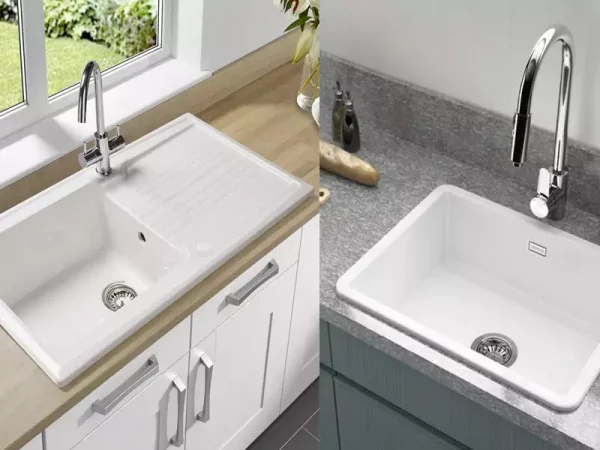
When you want it the traditional way, a porcelain kitchen sink is a good pick.
This type of kitchen sink material is offered in a wide array of colors, textures, patterns, and installation options which makes them fit for both contemporary and traditional kitchen areas.
One good factor for porcelain kitchen sinks is their low maintenance feature. Because this material is hard, dense, and non-porous, you won’t have to worry about maintaining them as hefty as the other kitchen sink types.
However, one thing to keep in mind with porcelain sinks is their vulnerability to chipping when they are handled roughly.
Tossing in heavy-duty cookware and knives on your porcelain or ceramic kitchen sink is strongly prohibited as it can surely damage the protective coating.
Budget-wise, this pretty much works best. It is cheaper than stainless steel and requires the most minimal maintenance.
Pros of Porcelain Material:
- Hard material
- Dense
- Nonporous
- Low-maintenance
- Cheaper than stainless steel
Cons of Porcelain Material:
- Prone to chipping when handled roughly
- The protective coating should be handled with care
9. Acrylic
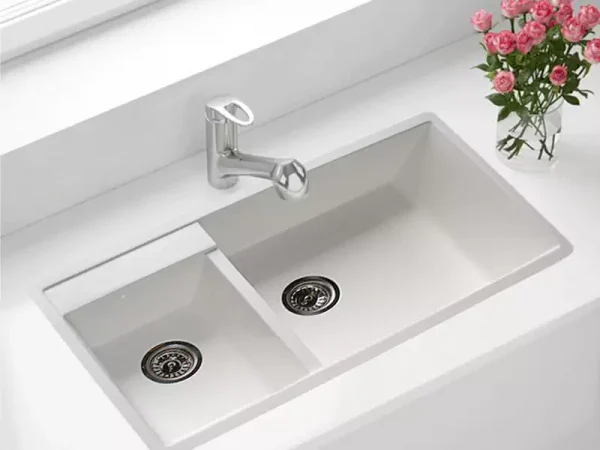
One of the cheapest among all the kitchen sink types, acrylic kitchen sinks are now making their way in the industry as well.
Acrylic kitchen sinks are usually made from polycarbonate plastic or fiberglass. Because of this material’s high malleability property, it is widely offered in many shapes and designs. It also has many color options.
This kitchen sink style is also very repairable. Any scratches and stains can easily be buffed out and polished off from acrylic sinks.
Because it is way softer compared with other sinks, it is also considered one of the quietest kitchen sinks.
It is very lightweight and very easy to install. You will also not need to worry about your glassware breaking while washing because it’s not as hard as stone sinks.
One major downside to acrylic is its inability to withstand heat and petroleum-based solutions like paint. It is also not as durable and long-term compared with the other kitchen sink material options.
Pros of Acrylic Material:
- Comes in many colors and design
- Can be buffed or polish off rough surfaces
- Lightweight
- High enduring
- Not damaging to dishes while washing
Cons of Acrylic Material:
- Not able to withstand high heat
- Not durable in long term
10. Solid Surface
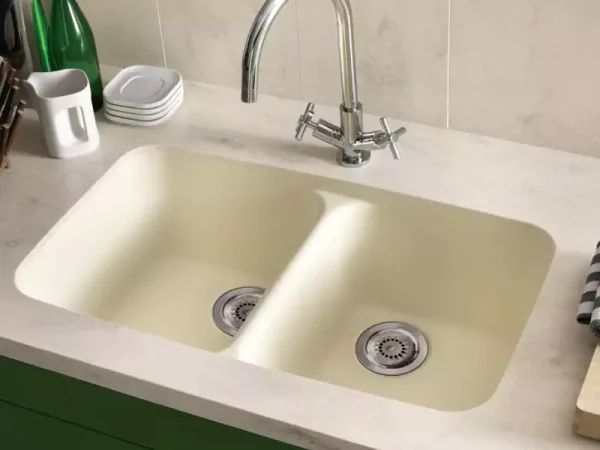
If you want the look of enamel without spending as much, this is the answer for you.
Solid surface kitchen sinks are starting to make a name and are keeping up with other popular kitchen sinks nowadays.
Due to its very affordable cost, low maintenance, and very appealing designs, it really gets the attention of buyers.
This material is basically a man-made acrylic resin or polyester mixed with mineral compounds. This duo produces a very durable and non-porous surface which makes it impenetrable from other food particles and won’t build up bacteria as long as you clean it after every use.
This is usually best for undermount sinks as it seamlessly joins the countertop, forming one piece. There will be no crevices between your countertop and your sink which makes it very easy to clean and impervious to moisture and grime build-up.
A few reminders when you choose to have this sink is to keep it away from metal scouring pads because it is very prone to scratching when mishandled.
Also, refrain from placing extremely hot items in it since its heat resistance is limited up to 400 degrees Fahrenheit only.
Pros of Solid Surface Material:
- Affordable
- Durable
- Customizable
- Not very heavy weight
- Low maintenance
Cons of Solid Surface Material:
- Discoloration over time
- Sensitivity to extreme heat
Key Factors to Consider Before Choosing A Kitchen Sink Material
If you’re still puzzled about how to choose the right material for your kitchen sink, here are some tips that you can take into consideration.
Durability
This is the main factor to consider before selecting a kitchen sink material. The hassle that repairs and replacements give you is really not admirable. That’s why people really put into consideration the durability and longevity of the item.
Stainless steel kitchen sinks could last for 20 years.
Style and colors
Most kitchen areas today have their own themes and accents. If you are into this trend, you can choose between cast iron enamel, fire clay, or pure stone as they are the ones that are offered in many styles and different colors.
Copper kitchen sinks are good for vintage-themed kitchen areas. Glass sinks can also match most modern themes of today.
Maintenance
If you want an easy-maintenance kitchen sink material to match your busy schedule, stainless steel sinks are desirable for you.
Fireclay and cast iron enamel are also ideal as they can be easily cleaned with a wet cloth and a mild cleaner.
Pure stones and coppers are sensitive to acidic cleaners and require cleaners with specific pH levels.
Budget
Some sinks like pure stone and copper are very pleasing to the eyes and can give you good functionality but it is highly expensive. That’s why most people hesitate to purchase one. If budget is a concern, opt to buy cheaper resemblances like composites or stainless steel sinks.
Common Kitchen Sink Mounting Style
1. Top-mount Kitchen Sink
This type of sink is simply dropped into a hole on your countertop. Also called a self-rimming sink merely because it has a rim that will be responsible for holding it in place. The weight of the sink is carried by the rim.
When the sink is inserted thoroughly and is already sitting in place, you can simply caulk the sink on the countertop.
This requires no professional installation. You can simply do the installation on your own. This is also advantageous due to its low cost.
However, one downside of this sink is the probability of scum and bacteria accumulation between the rim and the countertop when not sealed properly as the rim hinders the water from flowing directly to the sink. To properly seal, check this guide to select the best caulk for sink installation.
2. Undermount Kitchen Sink
From the name itself, this is basically the opposite of a top-mount sink. Unlike the top-mount sink, this type of sink has no rims. Instead, it is attached to the underneath of your countertop with the help of special undermount sink clips.
Cleaning is much easier in this type of sink as it has no rim to block the way from seeping the water and food particles straight into your sink.
You will be able to ensure that no scum is going to accumulate on top of your sink due to it having no crevices.
You just need to constantly check that there is no gunk build-up underneath your countertop.
One main concern in this type of sink is its cost because this is known to be more expensive compared with top-mount sinks.
When you purchase undermount kitchen sinks, this will require a professional upon installation.
They will have to attach an internal support system to secure the stability of your sink. This obviously adds up to your expenses as well.
3. Farmhouse Sink
If you love a traditional-looking or country-style themed kitchen, choosing the best farmhouse sink would be the right decision!
This is also referred to as an apron sink. From the name itself, it portrays an apron look and it’s the very focal point of your counter front.
Your cabinet will have that very country-style feel as the sink itself will stand as your kitchen accent. This is usually installed on top of a cabinet or a freestanding table that is fixed against the wall.
There are so many farmhouse sink materials you can choose from. Farmhouse sinks are available in both single and double-basin. People love this kitchen sink style due to its large size that can accommodate large size kitchenware.
This also gives comfort to the person using the sink because the very little space between the edge of the counter to the sink won’t strain your back.
You just have to be careful while washing because the water from the sink might drip directly towards you due to its very narrow barrier.
This also costs a lot more compared with other kitchen sink types.
Kitchen Sink Types According to Basin
1. Double Basin Sink
This type is one of the most popular types of arrangement for kitchen sinks.
Basically, this sink has dual basins which allow you to wash on one side and rinse or dry on the other. It is indeed one multi-purpose sink.
It can be a 60/40 double basin sink which means one sink is bigger than the other. A 50/50 sink can also be an option which means both basins have the same equal sizes.
This type of sink is very ideal for households that have no dishwashers. It will really make dishwashing extra convenient.
However, because the sink is divided into two parts, either side might be too small when washing large size kitchen wares.
2. Single Basin Sink
If space is your utmost concern, you may want to have a single basin sink. As the name suggests, this type of sink has no division. This is a general category of most kitchen sinks such as farmhouse and in-counter sinks.
This in a way is advantageous when it comes to big households and busy cooking and washing activities. This can surely accommodate large items and won’t hassle you of constantly washing by piece since you can stock them and wash them all at once.
However, because it is not divided, you’ll be required to have a drying area for your newly washed dishes and kitchen wares which is not very ideal for small kitchen spaces.
Top 5 Kitchen Sink Brands
- Houzer
- Elkay
- Kraus
- MR Direct
- Kohler
Factors to Consider Before Choosing a Kitchen Sink
Now, what makes a kitchen sink perfect?
There are several factors that will define perfection. However, we will categorize it into five factors to help you decide and pick the best sink for you.
Material
Did you know that the material of your sink plays almost 40% in your kitchen sink’s functionality?
Well, it’s true that there’s no material that fits all. However, choosing the best material definitely depends on each one’s individual needs.
As we have discussed the different sink material examples earlier, each kind is different from another. Each of them has its pros and cons.
If what you value most is aesthetics, then we suggest that you get either pure stone, copper, or fireclay. On the budget side, acrylic.
These materials are sold in various styles and designs. You will definitely be able to find one that will suit your kitchen theme.
When you prioritize functionality and practicality over aesthetics, you will never go wrong with a stainless steel sink. This is affordable yet will last you for years.
The most budget-friendly are the acrylic and porcelain sinks. They are suggested for people who like aesthetics but do not seek longevity.
Size and Depth
These two factors may be the least priority but they also play a role in making your sink perfect. Deep sinks will have bigger spaces for dishes and can accommodate massive kitchen wares.
However, you also need to consider that the deeper your sink is, the bigger space it will eat up from your cabinet. Deeper sinks also cause back pain and discomfort, especially for short folks.
Size also matters!
This is one important factor to consider upon purchasing a sink. Choose a sink that perfectly matches your working space.
If you have a big kitchen area, it’s good to have a 3 compartment sink as cleaning and sanitizing in three compartment sink is easier.
Installation Style
This is another important thing to consider because this also affects other elements in your kitchen.
Choosing which sink affects your countertop and cabinetry. Keep in mind that each type has its own pros and cons. If you want a budget-friendly sink that is easy to install, go for the drop-in sink.
If you want a seamless look without worrying about the cost, an integral sink is a good choice because it will be made from the same material as your countertop and will be fabricated with it.
Apron front sinks are also aesthetically beneficial. It can match your organic or modern kitchen feel. It is also not very costly which is an advantage.
Design and Shape
Well, of course, design and shape should never be forgotten.
You can make your kitchen sink the focal point of your kitchen. Your sink should always complement your kitchen area.
If your kitchen area has a lot of stainless steel appliances, a stainless steel sink can match it. If you want a classy or vintage look, go for pure stone and copper.
Always remember that aesthetics and functionality go along.
Shapes also help with convenience.
Sinks with round edges are easier to clean and you can assure that no food and dirt will get stuck in the corners. However, sinks with corners add to your kitchen a modern vibe. It also offers a bigger volume compared with those that have round edges.
Number of Basins
I’m pretty sure that you’ve seen houses with sinks that have two basins. Some even have three. Others still choose the solo basin type.
Well, although it looks a little obvious it does have its own uses too.
A two-basin setup enables you to prepare food in the first basin and clean up in the second one.
Some homes even upgrade to three-basin sinks. It has two same-size basins and a smaller one in the middle. This is ideal for households that usually welcome guests and a family with 8 to 10 people where cooking is massive every time.
Some also stick to a single large basin. This is usually present in the modern kitchen setup. With this kind of basin, you can easily purchase a few detachable add-ons that will make your single basin sink very useful.
Why You Need to Choose the Right Kitchen Sink Material
We all know that kitchen sinks play a very big role in every home. They make our dishwashing, and even hygienic practices way easier and more convenient.
That’s why it is of utmost importance to choose the best kitchen sink material for a couple of good reasons.
When you have the right material, it will save you from worrying about how to maintain it. One factor of a good kitchen sink is easy maintenance.
It will also save you dime and time from constant repairs or worse– replacements. The right material will surely serve you a long time.
It will also improve your kitchen look. Of course, functionality is very important but having the right material should also complement the look of your kitchen area.
FAQs
1. What is the Easiest Sink to Keep Clean?
Well, by far, stainless steel sinks take the number one spot as the easiest sink to keep clean among all the kitchen sink material options.
With just the use of your non-abrasive cleaners, you can easily wash your stainless steel sink. Just make sure to wipe it dry after every use to prevent water spots.
Its non-porous property makes it ideal. It is impenetrable from dirt and grime. Any scratches can also be buffed off using the right cleaner.
When you need to sanitize your stainless steel sink, you can just easily sterilize it using hot water to kill germs and bacteria. Since it is rust-proof, you will not need to worry about dirt and grime build-up that might lead to rusting.
2. What Type of Kitchen Sink is Most Durable?
Durability is connected to longevity. If you’re asking what’s the toughest material among the different kitchen sink materials that will serve you throughout the years, it is safe to say that it’s pure granite stone.
Although this costs way higher than others it will really last you for ages. With proper handling and regular sealing, it will be at its top functionality.
It never rusts and it is dirt and stain-free due to its glossy finish. It is also very strong and can withstand extreme heat.
However, if you’re on the budget concern side, stainless steel is for you!
It can withstand heavy-duty use, does not rust, and is non-porous. As long as you get a good gauge stainless steel sink, you will never worry about dents. It also does not chip or crack. With just the proper maintenance, this will surely last you around 15 to 20 years.
3. What is the Latest Trend in Kitchen Sinks?
As time flies, trends also come and go. But for the latest trends of 2022, a few special points were given by experts that you might also want to apply in your homes.
- Workstation sinks- this is truly very modern and trendy nowadays. Workstation sinks are those that have detachable items like colanders, strainers, cutting boards, and many more. This is practically sought-after, especially by moms and homeowners with small kitchen spaces.
- Apron front texture- apron front sinks have always been a classic style but what makes them trendy these days is their textured front. Some sinks have coastal-inspired wavy texture, some are matte finished.
- Organic and natural-looking- experts say that the colors orange, aqua, and beige are the most appealing trio these days. Merely because having that natural and organic feel is what makes a kitchen very attractive in these trendy times.
4. Are Quartz Sinks Better Than Stainless Steel?
Both quartz and stainless steel have their fair share of pros and cons. It solely depends on your need for you to decide which is best.
Quartz is very ideal for aesthetics and looks. It will surely add high value to your kitchen area. It is widely offered in many styles and colors. It is also very durable and strong.
Being non-porous in nature makes it impervious to dirt and grime. However, you need to be careful not to shock it with extreme heat as it might crack.
Stainless steel on the other hand is very budget-friendly. It is rust-proof, dent-proof, and very resistant to heat. No need to worry about massive dishwashing because stainless steel sinks are built for that.
However, it is only offered in one color only which is silver which is a drawback for people concerned with themes and colors.
5. Undermount or Overmount Sink?
Choosing between the two should be dependent on the following factors:
- Budget- know that overmount sinks are cheaper than undermount sinks. Because undermount sinks are more complicated to install, this will also require a professional’s help which basically adds up to your total cost.
- Preferences- both of these two types of sinks have their fair share of advantages and disadvantages. Some prefer the undermount sink because it looks clean and modern. Others also prefer the top-mount sinks because it looks traditional and is easy to manage. Choosing between the two depends on which one you prefer the most.
- Installation type- as we have discussed earlier, overmount sinks are very much easy to install. Simply insert it in your countertop hole and caulk the sides and off you go. If you want something that’s cheaper and easier to install, overmount sinks are ideal.
- Countertop material- take into consideration the material of your countertop. Undermount sinks require strong countertop material so that it will be strong enough to hold the weight of your sink. Countertops that are not water-tight such as wood or discouraged. However, if your countertop material is non-porous such as granite and other types of stone or water-resistant composites, then using an undermount sink is possible.
What’s the Best Kitchen Sink Material for Your Home?
Stainless Steel.
It can never be denied that kitchen sinks play a big role in our homes. That’s why it is essential to know the different types of kitchen sink materials with pros and cons.
Choosing the best material for a kitchen sink will not only elevate the look of your kitchen area but also make your kitchen life easier and more convenient.
Which is the top kitchen sink material? Each kitchen sink material has its fair share of advantages and drawbacks too. I prefer stainless steel.
On the practical side, stainless steel kitchen sinks will never fail you. It is budget-friendly and very easy to maintain. It is also non-porous and will last you for years.
When durability, aesthetics, and style are of primary concern, fireclay is the most ideal one.
So, these top 10 types of kitchen sink materials are what I’ve researched, I hope now you have more knowledge as well. Just choose a kitchen theme and select the right material to remodel or upgrade a new kitchen.
